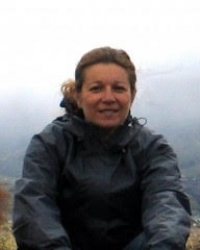Cotsen Institute's Visiting Scholar Sonia Zarillo

Sonia Zarrillo is a postdoctoral fellow who describes herself as an anthropological archaeologist with a specialization in paleoethnobotany, the study of the interaction between people and plants in the past. Her current research projects center on the pre-Columbian history of cacao and the adoption and use of plants in the Andes, from sea level to the highlands and from PaleoIndian to modern times. In addition, she has been named director of the Ancient Agriculture and Paleoethnobotany Laboratory (AAPL) of the Cotsen Institute. In 2018 she was the first author of an article in Nature on the domestication of cacao in the Amazon Basin. Recently she presented a Pizza Talk on “Adventures in Paleoethnobotany” and participated in the symposium “Visualizing Plants: Productive Ways to Present Archaeobotanical Data” during the annual meeting of the Society for American Archaeology.
How did you get interested in paleoethnobotany?
“Throughout human history, from our earliest ancestors through to modern societies, plants were of vital significance. They have been essential to diet, used as medicines and in ceremonies, fashioned into a myriad of tools, containers, adornments, and musical instruments, depicted in artwork, used as emblems, and relied on as a source of fuel and building material.”
At the University of Calgary, where Zarillo did both her undergraduate and graduate studies, she took a variety of courses, including one in paleoethnobotany from a professor she had studied with previously and was very attracted to the subject. She enjoyed many of the archaeology classes, but admits that “you just cannot do it all. I really loved zooarchaeology, human osteology, and lithic analysis, but we are all so specialized now,” she continued. “My background has been very diverse, and I find that knowing a lot about stone tools or animal bones versus human bones,” is very helpful. As an example of this multi-faceted study, her PhD dissertation was on analysis of artifacts and plant remains from sites in Ecuador, in the highlands and the eastern cloud forest, complementing her previous research on the coast.
What are you concentrating on now?
“The broadest project is the research in Peru, which includes a multi-institutional, international group. It is actually the oldest, highest, ice-age site in the world,” she added. One of the questions we are trying to answer is “were people living primarily at the lower elevations and making trips up to the highlands to procure resources?” For example, the project found obsidian both in the highlands and in a coastal site, which is the main phenomenon that links the two sites, according to Zarillo.
Another project that Zarillo is working on is the ongoing research into chocolate. She explained that while other people have done research on cacao and identified it based on chemical markers, “we expanded the research to include chemical residue analysis and ancient DNA….and this showed that we had the earliest domesticated cacao in the Americas in southeastern Ecuador.” The importance of this find, which was the basis of the article in Nature, was that previously it was thought that cacao was domesticated in Mesoamerica.
What are you doing in the AAPL?
“Right now I am busy setting things up because I am adding techniques that have not been used in that laboratory before. Within paleoethnobotany, one of the techniques is to look at macrobotanical plant remains, or what you can see without magnification. Although I do that, my real specialization has been in microbotanical analyses: using techniques to recover microscopic plant remains adhering to artifacts, such as stone tools and ceramics, recovering them, and identifying them.”
Most importantly, what is your reaction to living in Los Angeles in contrast to your home in Calgary?
"I have always loved California. As far as the weather, I can honestly say that I will never miss winter and I can always go and 'visit' the snow right here in southern California if I really want to, or go home for a visit! Being of Italian heritage I have always jokingly said that I am genetically suited to a Mediterranean climate. It is also a gardener’s paradise here; that is one of my main hobbies and now I can do that year-round."
Zarillo is very enthusiastic about collaborating with colleagues and students at the Cotsen Institute, the Department of Anthropology, and other departments at UCLA. “It is an invigorating atmosphere to be in, with people researching such a diverse array of topics, regions, and time periods.” Her work with Deidre Whitmore in the Digital Archaeology Laboratory, where they worked together to create an interactive 3-D map of a rock shelter site that shows where her plant samples came from, was recently presented at the 2019 annual meeting of the Society of American Archaeology and was well-received. She hopes to continue this work and be able to allow users to tell how the plant remains relate temporally and spatially to the animal remains and the stone tools at the site. "It would be great if at some point, they could even click on a site and see the rock art," she added.
Published on May 1, 2019.


